
This Glossary is for our Audit tool. If you're looking for resources about Content Audit, you can just go ahead and navigate here instead.
As the name suggests, our Audit is useful for reviewing existing content. It allows you to compare your article's SEO practices to your direct competitors.
Action corresponds to what you must do to meet the suggested range for a specific part of your page.
You may need to add some occurrences of a specific element, remove them, or keep the number unchanged.
Elements of your page that are anchored/hyperlinked, including images and text. Anything between tags is an anchor.
If some suggested keywords, images, or headings are hyperlinked, we would not count them towards occurances.
Anchored content is not calculated towards the score, as it describes the page it links to rather than the page it's on. So if you're making a hyperlink out of a term, you're telling the crawler: Hey, this page is about what I wrote in my code's tag.
In other words, it counts more toward optimizing the linked page than the content you're optimizing.
This approach helps us make more accurate suggestions, allowing us to exclude the navigation, menu, and footers from the suggestions and calculations.
Everything that is within your page's tags and the main subject of Audit analysis, including hidden content and things like image alt-texts.
Excluded from the analysis are hyperlinked content/anchored elements.
Competitors are the websites that, when creating a query, are in the top 10 ranking spots in Google for your targeted word and location combination.
The suggestions are only based on the competitors selected.
To choose the competitors for the analysis, click on the Gear icon, and based on your knowledge and experience, select the competitors you want to benchmark your content against. Here's a list of a few tips that will help you in this process:
Try choosing competitors with well-optimized content. In other words, select those with a Content Score of 60+.
You can avoid selecting domains with high ranking places and authority, but very low Content Scores. Comparing your content to theirs will be counterproductive. These domains owe their high position not to good SEO practices but to their domain's high authority—for example, Wikipedia, Quora, or Amazon.
You can avoid selecting domains with a different search intent than your page. If you are running an informative blog, you should not choose any e-commerce businesses.
Select at least three competitors for the best results.
Crawler is Surfer's bot used to scan your & your competitors' websites.
SERPs and domains may differ slightly depending on whether you are searching for a word on your computer or mobile device.
Our desktop crawler is a bot that looks at the top pages of the SERPs for desktop devices and crawls the desktop versions of those sites.
Our mobile crawler is a bot that looks at the top pages of the SERPs for mobile devices and crawls the mobile versions of those sites.
Credits correspond to how many times per month/year (depending on your plan) you can use Audit.
Our current plans (Essential and Scale) both allow you to run 100 Audit queries per month.
One Audit query equals one credit from your limit.
Content Score is a numerical value between 0 and 100 that corresponds to the quality and relevance of the website's content to a given keyword and location combination.
Your Content Score for the same piece of content may vary depending on the query parameters (keyword, crawler, location, selected competitors) and query type (Content Editor, Audit).
SERPs and domains may differ slightly depending on whether you search for a word on your computer or mobile device.
Desktop crawler is our bot that looks at the top pages from the SERP for desktop devices and crawls the desktop versions of those sites.
Check Mobile crawler 
The exact keyword is the term you used when creating your Audit query – the word you provide with the targeted location and the page URL when creating the query. In this example, the exact keyword is "b2b content marketing".
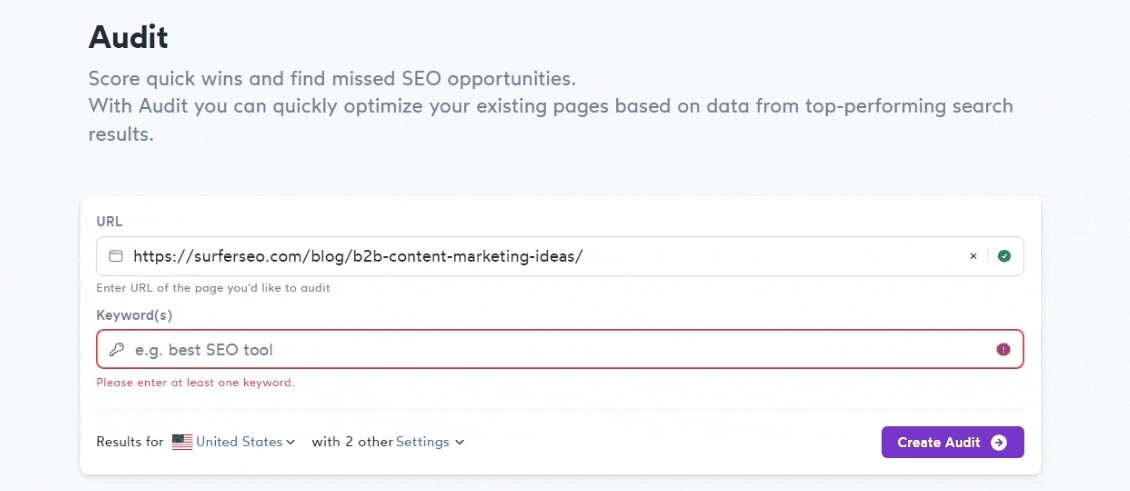
Surfer will show you how many times your competitors used this keyword on their pages and make suggestions according to good practices, like putting at least one exact keyword in your title or h1.
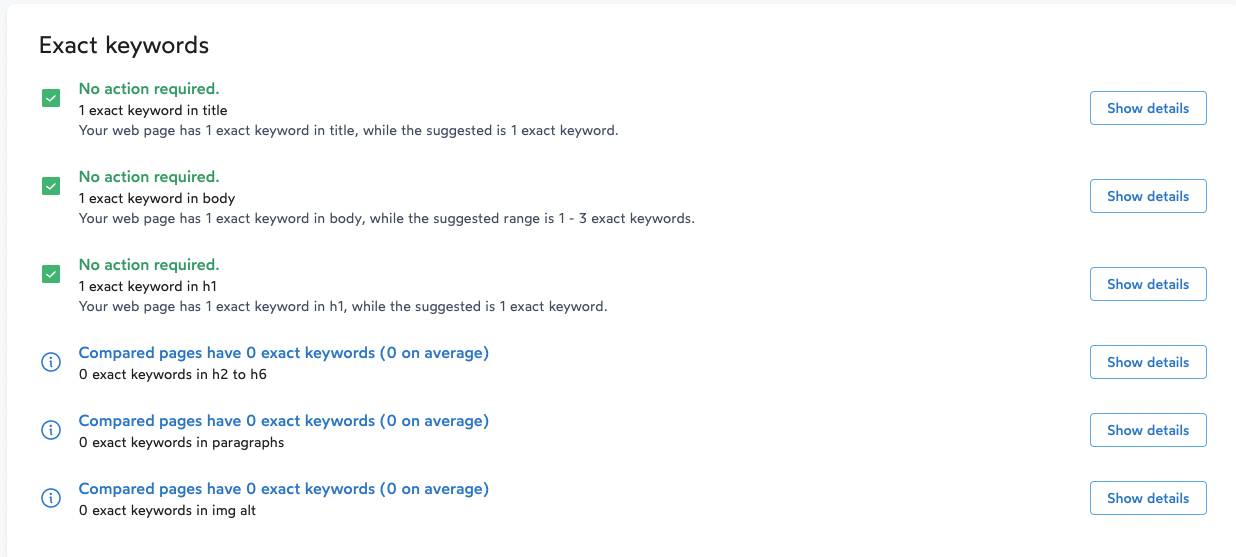
An H1 tag is an HTML heading used to mark up and highlight a webpage's main subject.
Your H1 is anything that is between
tags in your webpage's source code.
A page should generally have only one h1 element, and adding more is rather considered a bad practice.
HTML subheading tags improve your webpage's structure, sectioning, and readability.
Your H2-H6 content is anything between tags in your webpage's source code.
A page can have multiple H2-H6 elements.
Elements of your page that are anchored/hyperlinked, including images and text. Anything between tags is considered an anchor.
If some suggested keywords, images, or headings are hyperlinked, we would not count them towards occurances.
Anchored content is not calculated towards the score, as it describes the page it links to rather than the page it's on. So if you're making a hyperlink out of a term, you're telling the crawler: Hey, this page is about what I wrote in the tag of my code.
In other words, it counts more toward optimizing the linked page than the content you're optimizing.
This approach helps us be more accurate with the suggestions as it also allows us to exclude the navigation, menu, and footers from the suggestions & calculations.
Building the proper structure of your domain using internal links is one of the essential things to do in SEO.
Surfer will look up linking possibilities using the site search and suggest other URLs within your domain you should consider as internal links sources.
The internal links from the suggestions section are meant to redirect users from one of the suggested pages to the Audited page. The URL to the Audited page has to be somewhere on the recommended page - not the other way around.
This section corresponds to the number of image elements on your and your competitors' pages.
If some images are hyperlinked, we would not count them towards occurrences.
Check hyperlinked elements 
Our crawler will measure the time it takes for your page to load and compare it to how long your competitors' pages load (on average).
Please keep in mind that this is a technical SEO element which is why Surfer won't be able to give you specific optimization tips for this part of your domain.
Top-ranking pages may vary depending on the search location. If you are in Poland, your "pizza" Google search will provide different results than in Germany.
You can select a country or a city for more local-oriented businesses.
Once a query is created, you cannot change the targeted location. If you selected the wrong location by mistake, contact our Support team via live chat or at [email protected].
The purpose of the Check icon or "Mark as done" button is solely organizational. Once you click on it, you will see a green check mark on the main dashboard with your Audits.

You can unmark it as done directly from the draft or through your Audit dashboard.
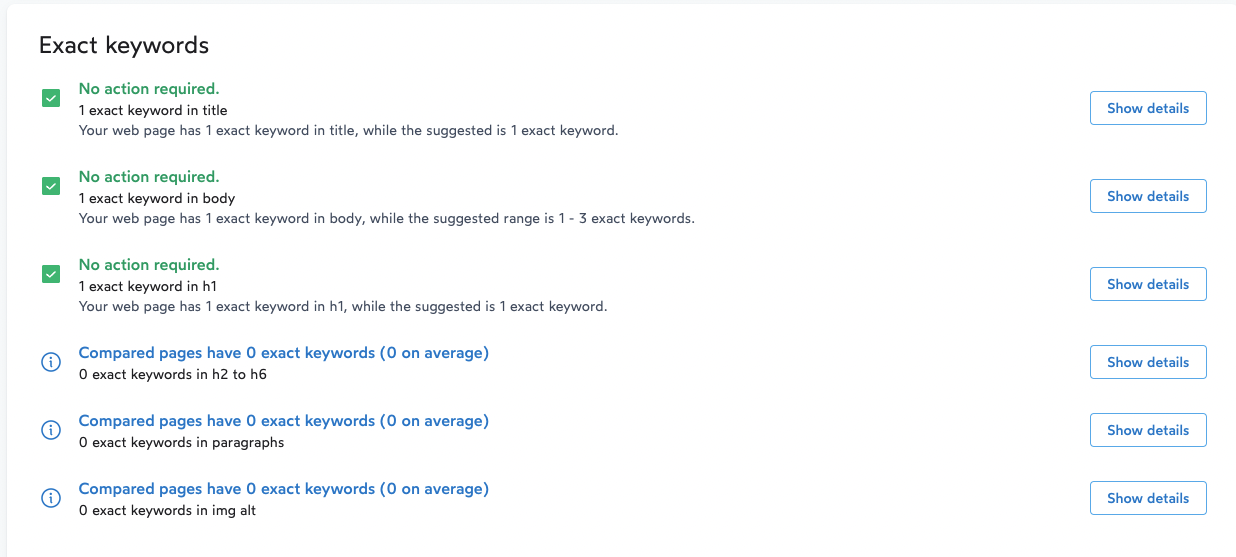
SERPs and domains may differ slightly depending on whether you are searching for a word on your computer or mobile device.
Mobile crawler is our bot that looks at the top pages from the SERP for mobile devices and crawls the mobile versions of those sites.
Check Desktop crawler 
NLP stands for Natural Language Processing. It allows our crawlers to understand the written text more contextually.
While Google created its NLP algorithms for general purposes, Surfer NLP is slightly more SEO-oriented. AI-powered techniques measure and analyze each top Google search result, making SEO efforts more effective.
NLP is automatically enabled for queries targeting a language with NLP support. Depending on the language of the query, Surfer uses either the NLP API of Google or our own NLP engine to extract data about entities and sentiment. To deepen our analysis and make the data actionable, we cross it with our True Density calculation.
NLP connected with Google API supports English, French, German, Italian, Japanese, Korean, Portuguese, Russian, Spanish, Simplified Chinese, and Traditional Chinese, whereas Surfer NLP only supports Polish, English, Danish, and Dutch.
If you are seeing this message, it means that our crawler has faced an issue when attempting to crawl your page.
Partial keywords are counted when the first three letters of a word in your content are the same as the first three letters of the exact keyword.
For example: if the primary phrase is "b2b content marketing”, the partials will be any words starting with b2b*, con*, and mar*.
This section will guide you on how you can cover the content gap with partial keywords and will point out where you can add them. Sure, it’s probably not at the top of the list of priorities. We suggest that you focus on keyword density first, but every little tool we have to optimize content helps.
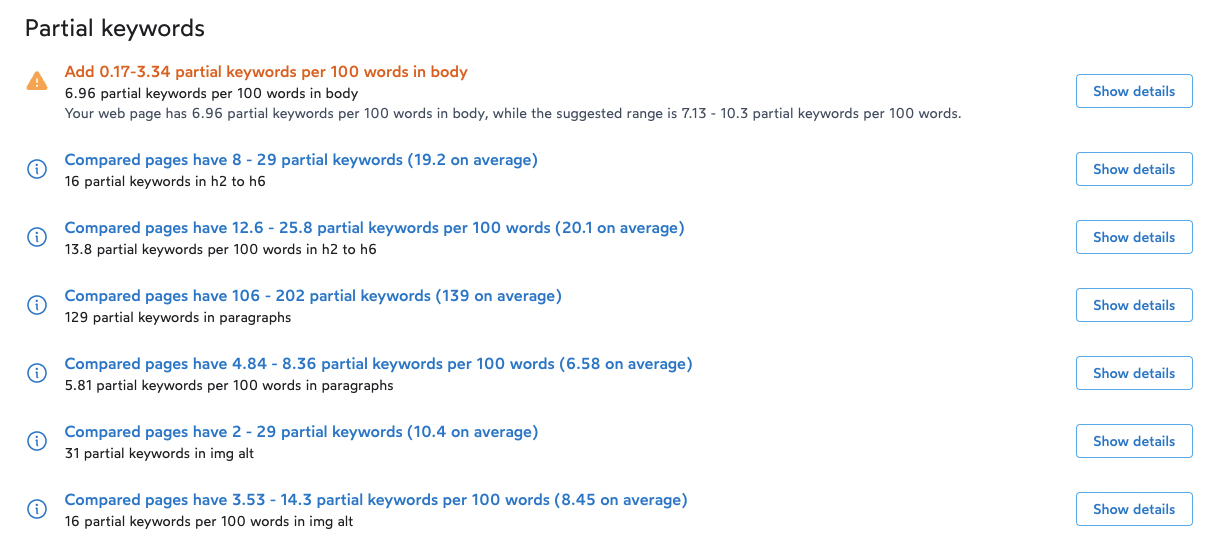
We’ve found that using this strategy helps to fill any content gaps; it allows for natural variations that other sites are using, which you don’t have to try and think up. It also helps the content read naturally, improving the user experience.
This section will analyze the structure of your page but will take into account only those elements that are visible and not anchored. It can't be placed within a tag, or its CSS display property cannot be set to hide.
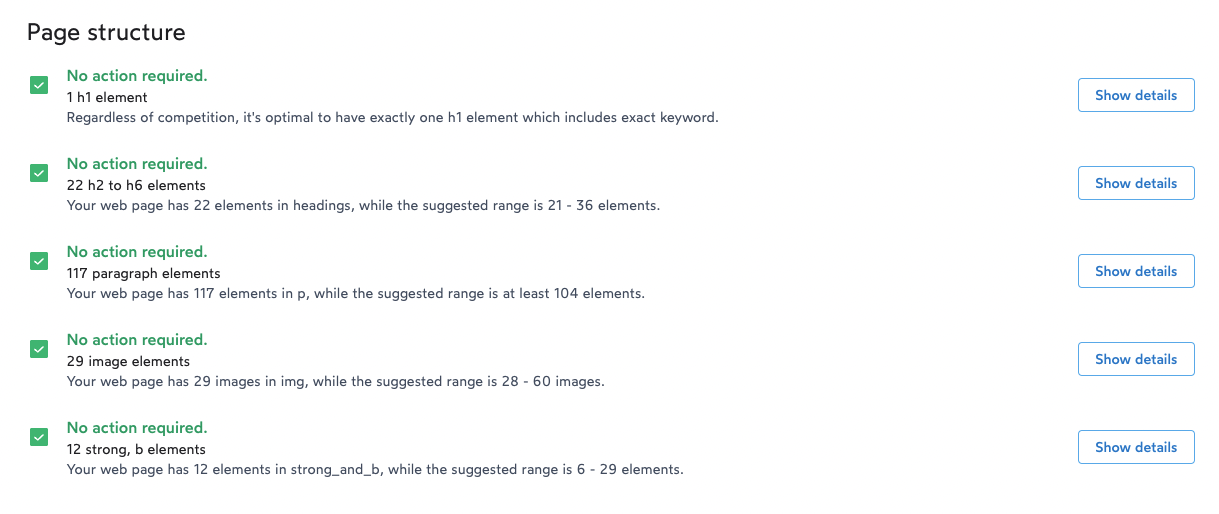
Always compare the Audit results with the reviewed version of the website. If you choose the mobile crawler, ensure you're viewing your page's mobile version, as the content may vary.
The number of words placed within the tag of the page's code. Usually, it's the main content on the page.
The calculation excludes hyperlinked content, but if you're seeing significant discrepancies, please check our troubleshooting article on the topic.
At Surfer, there are a few types of queries - Audit, Content Editor, Keyword Research, and SERP Analyzer.
Audit query is created once you provide the parameters (targeted keyword, URL, location, crawler) and click the "Create Audit" button.
Each Audit query requires one Audit credit. Once it's created, you cannot change any of the parameters. If you made a mistake, contact our Support team via live chat or [email protected].
We introduced the Refresh button to make tracking your changes and updates easier. Clicking it causes Surfer to re-crawl your page, allowing you to see the progress.

After up to a few minutes, your suggestions will reflect the changes you made on your page between running your initial query and refreshing the Audit.
Refreshing is not working for me 
 Please note that it will not cause Surfer to re-crawl your competitor's pages. The refreshing purpose is organizational, so that you can see your progress. You must run a new query if you want Surfer to recrawl the whole SERP for your targeted keyword.
Please note that it will not cause Surfer to re-crawl your competitor's pages. The refreshing purpose is organizational, so that you can see your progress. You must run a new query if you want Surfer to recrawl the whole SERP for your targeted keyword.
The keyword Relevance is a percentage number based on our calculations.
Surfer will also suggest those terms if the competitors have specific terms on their pages. Suppose a keyword has a high relevancy percentage. Our algorithm has analyzed its importance based on multiple factors, including how often the word is used, how many competitors are using it, and others.
The Share button allows you to share your Audit with anyone - even with those who don't have a Surfer account. And you also do not need to share your account to do that!
To copy the URL, click the 'Share' button at the top right corner of the page. The URL will be automatically saved in your clipboard, and you can now send it to others.
Words within your tags that are bold – either in or tags. Hyperlinked/anchored content is excluded.
Example:
My page is awesome! = 4 words
Surfer is cool = 3 words
Competitors are the websites that, when creating a query, are in the top 10 ranking spots in Google for your targeted word and location combination.
The suggestions are only based on the competitors selected, and the Select Competitors option will allow you to review them.
To choose the competitors for the analysis, click on the "Select competitors" button, and based on your knowledge and experience, select the competitors against which you want to benchmark your content. Here's a list of a few tips that will help you in this process:
Try choosing competitors with well-optimized content. In other words, select those with a Content Score of 60+.
Avoid selecting domains with high ranking places and authority but very low Content Scores. Comparing your content to theirs will be counterproductive. These domains owe their high position not to good SEO practices but rather to their domain's high authority—for example, Wikipedia, Quora, or Amazon.
Avoid selecting domains that serve a different search intent than your page. If you are running an informative blog, you should rather not select any e-commerce businesses.
Select at least three competitors for the best results.
Search Engine Results Pages (also known as “SERPs” or “SERP”) are what you see in your browser after looking up a specific keyword. You type something into Google, and what you get back is the SERP.
Good SEO practices or paid Google ads can help bring your page to higher positions in SERP.
Your webpage has x words, while the suggested range is between y and z words. That sentence is pretty understandable, but where do those ranges come from?
The lower limit is the average for your selected competitors, while the upper limit is calculated based on the competitor using the most words in their content.
Search intent (or “user intent”) is the WHY behind the search query. It answers why people look for stuff and what they expect to find.
There are four most widely recognized types of search intent: informational, navigational, transactional, and commercial.
When it comes to Audit and search intent, you must remember to select only competitors with the same search intent as your page. You do not want to compare an e-commerce business to an informative blog.
Sentiment is an option that can be enabled or disabled while you are creating your Audit query.
Enabling it will add a new column to your Terms to Use table. This column will contain a specific word's average sentiment (if detected).
Google doesn’t treat all phrases equally for all keywords. We also have to consider additional factors - including the sentiment analysis, whether positive, negative, or neutral.
Following the Terms to Use section suggestions will impact your rankings most.
This part would tell you exclusively which words and phrases you should use, which ones you're still missing, and what the suggested ranges are based on your competitors.

All of the above are based on our AI-powered algorithms. For the number of occurrences suggested, we take the average density on competitors' pages and recalculate it to apply it to your current word count.
In this section, you can check the server response time and how long exactly it takes until Surfer can load the first byte of your website. It is worth keeping this ratio as low as possible.
In general, the faster the page, the better, but please keep in mind that this is a technical SEO element, so Surfer will not be able to provide you with specific optimization tips for this part of your domain.

Surfer will check how long your title and meta description elements are compared to those of your competitors.
While we can't help you write these elements, we will give you tips to ensure you are meeting the SERP average length.

Word count is calculated based on your and your competitors' pages source code, and it's the number of words within the <body> tags. We are, however, excluding from the analysis any phrases that are hyperlinked.
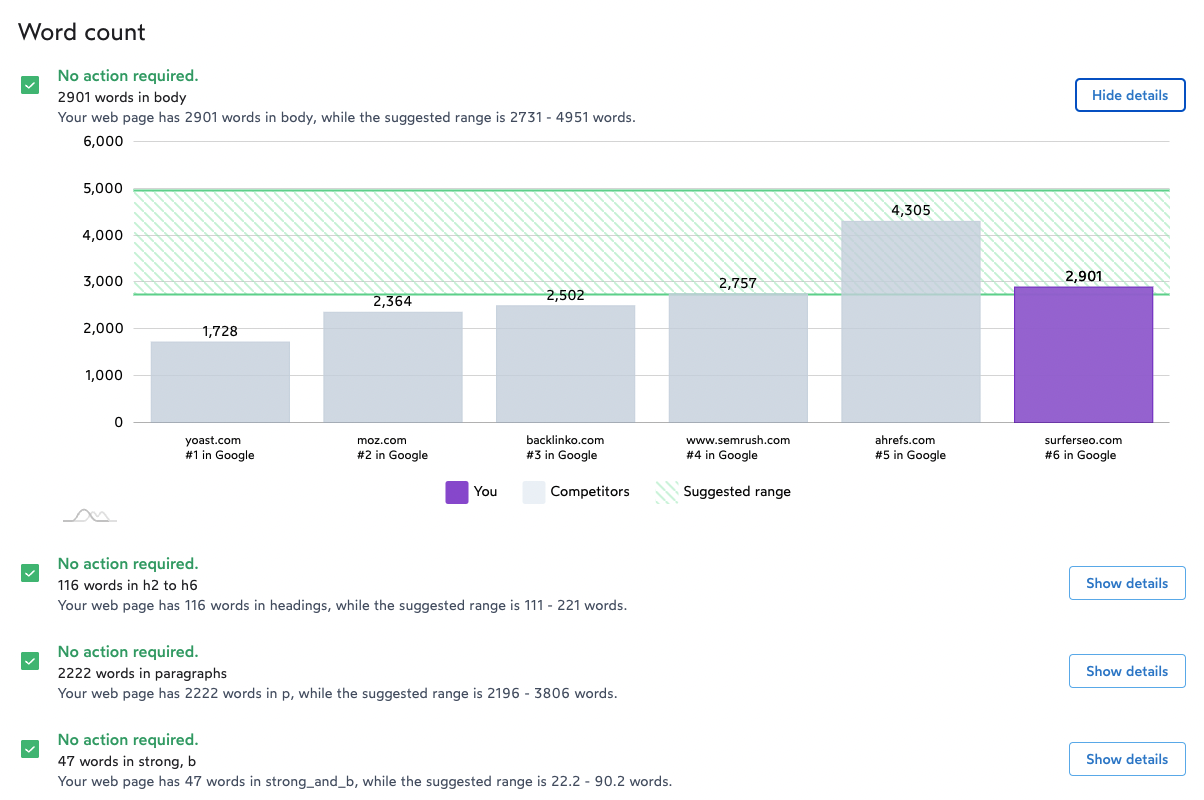
Words in body
This section analyzes everything within the <body> tag of the source code, not only the main content but also the surrounding elements.
Words in h2 to h6
The number of words in the headings, excluding h1.
Words in paragraphs
The number of words placed within the <p> tag of the page code. Usually, it's the main content on the page.
Words in strong, b
Words that are bold – either in <strong> or <b> tags.
The whole word count section depends powerfully on how the pages of your competitors are structured. For instance, if they used more lists (so respectively <li> or <ul> tags instead of <p>), they might have fewer words in paragraphs but the same amount of words in the body.